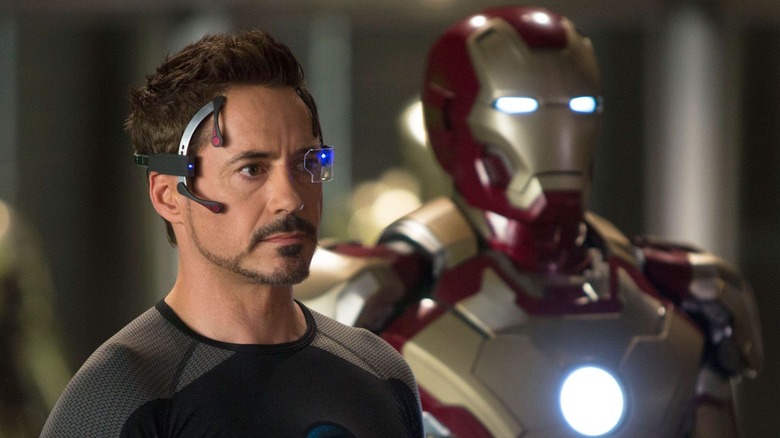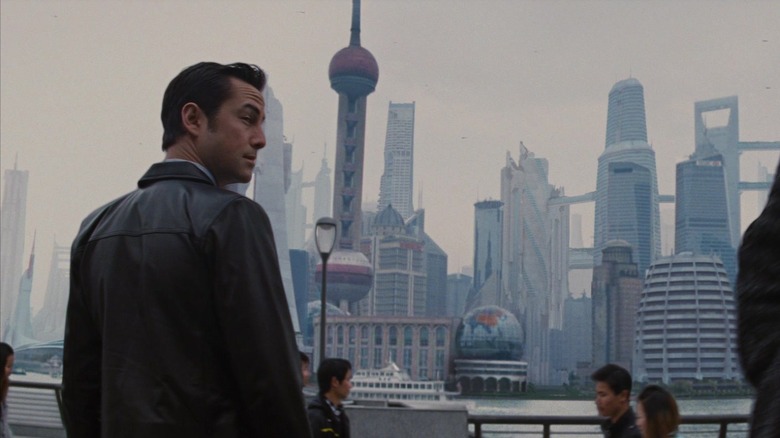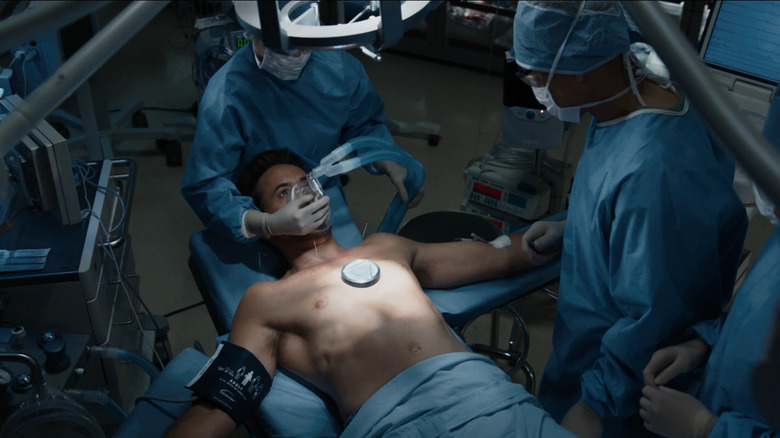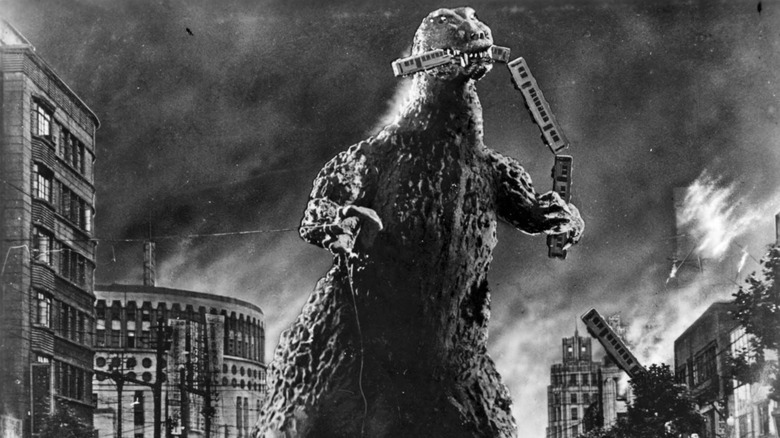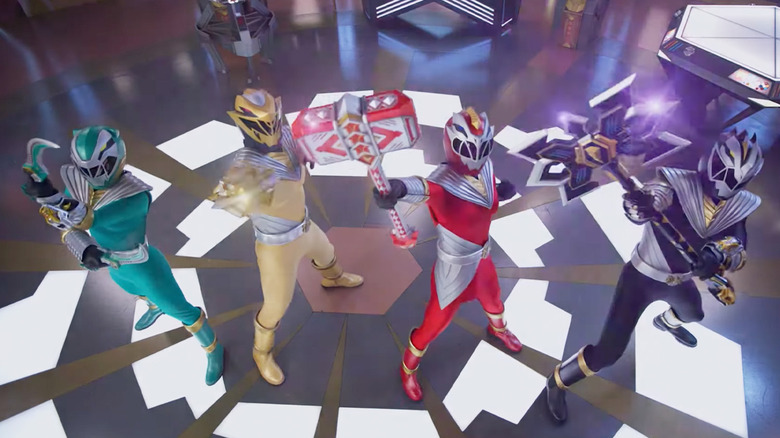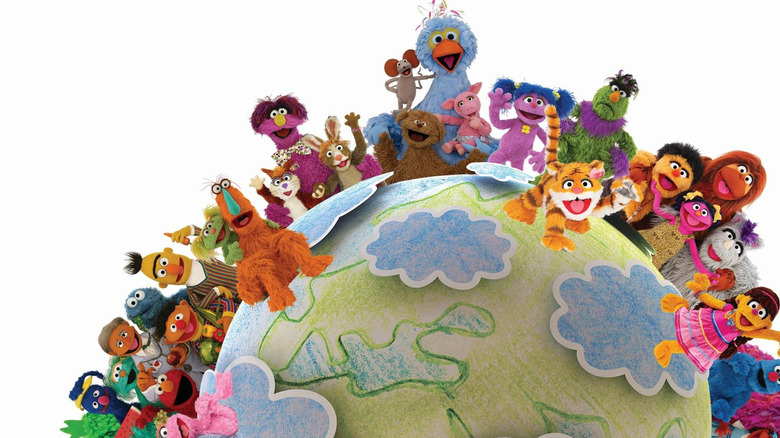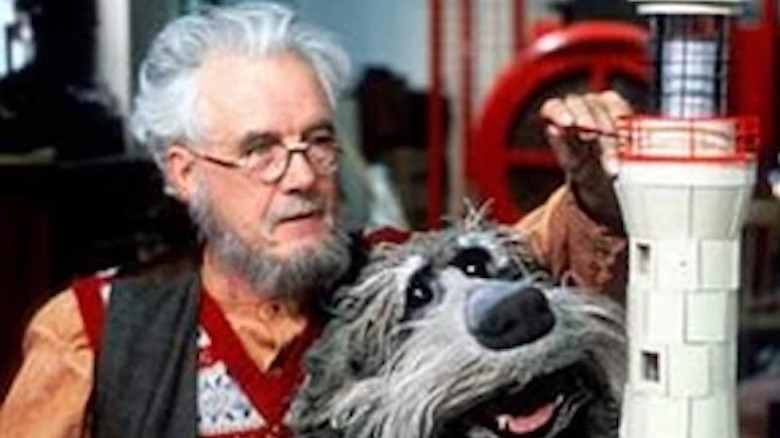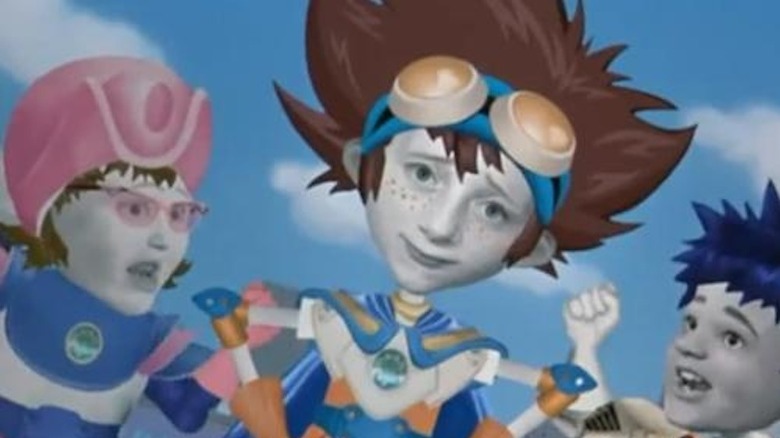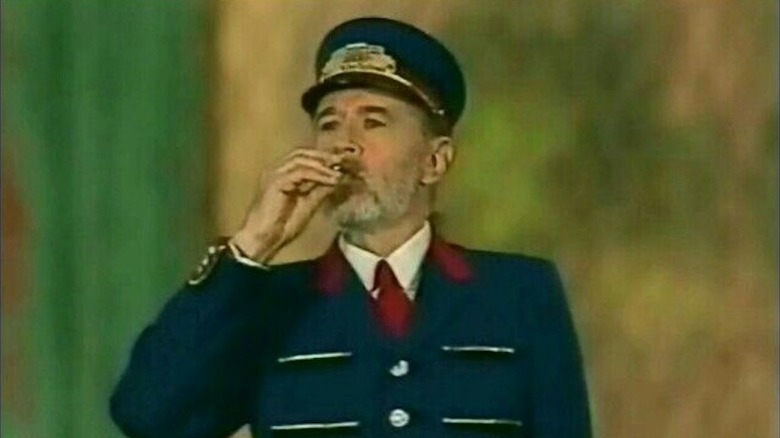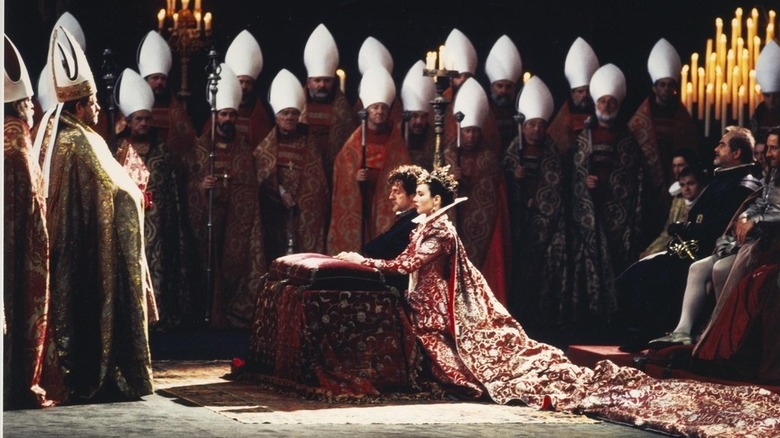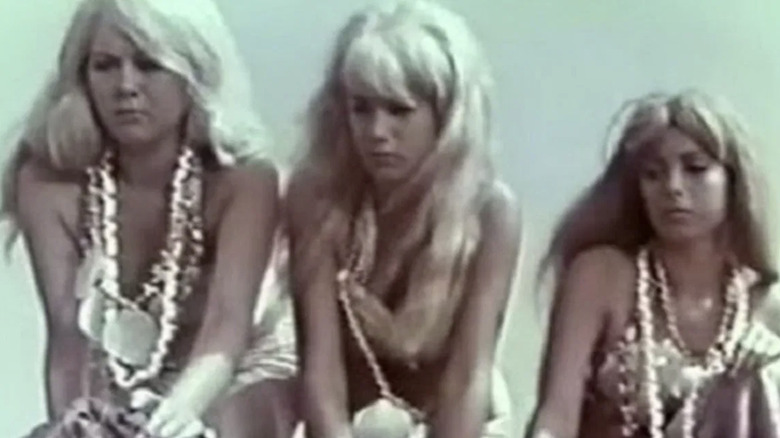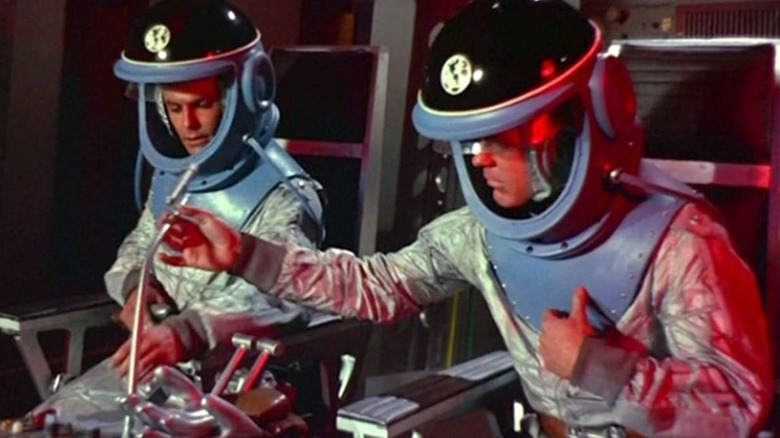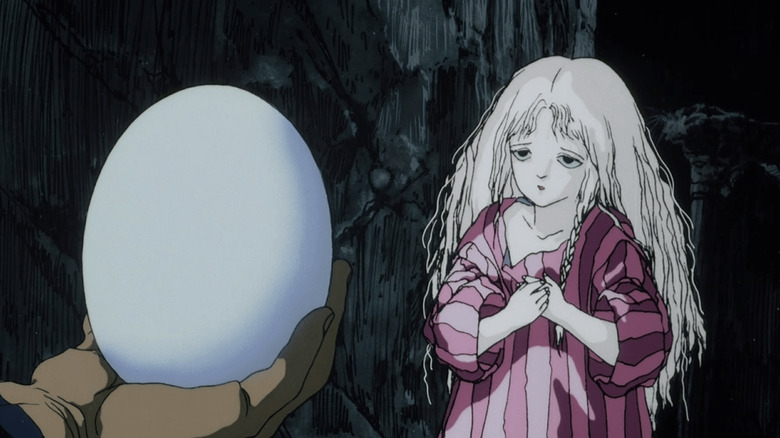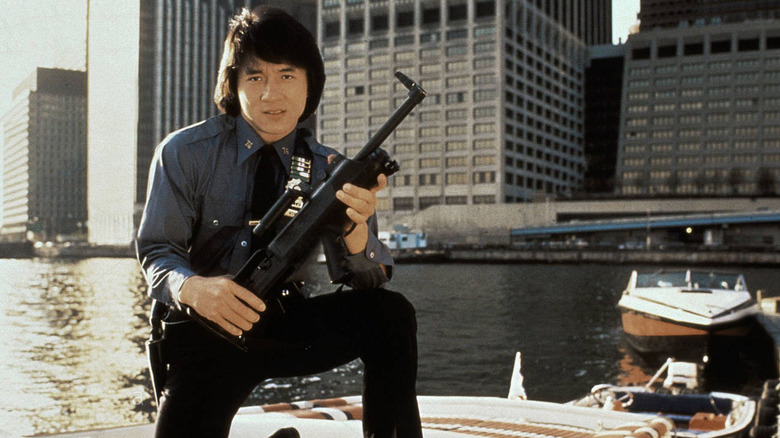Scenes That Were Made Specifically For Other Countries
Filmmaking is a global art form, but movies and TV shows don't always play the same way in different countries. On the most basic level, there's the general issue of translation — whether adding subtitles or dubbing dialogue, meaning and nuance can change when adapting a story to another language. There are also instances in which viewers in different countries are literally seeing different material. Scenes can get cut when a film or show gets exported, whether due to government censorship or scissor-happy distributors. Some productions even do alternate shots for other countries, either to adjust to cultural sensitivities or as bonus Easter eggs.
Then there are cases where international audiences get entirely new scenes that those in the film or TV show's home country did not. In rare instances, this new material gets added to international releases by the original producers, while more often, international distribution companies decide to essentially transform an acquired property into something new. Such extensive changes across markets are fairly uncommon today, but fans of old B-movies and a few major children's television franchises will be familiar with some of these examples.
Looper
In the early 2010s, Hollywood studios were willing to do anything to get a piece of the Chinese box office. DMG Entertainment, a U.S.-based company distributing American films in China, made it a mission to help Hollywood appeal to the Chinese market. One of its most successful co-productions was Rian Johnson's 2012 time travel film "Looper" (no relation to this website).
Self-destructing assassin Joe moves to Shanghai in a montage spanning the 30 years during which he ages from being played by Joseph Gordon-Levitt to being played by Bruce Willis. This montage — originally written to be set in Paris before DMG suggested to change it — passes by quickly in the American cut of the film, but plays out at greater length in the Chinese cut. An anonymous source connected to the film told the Los Angeles Times that the longer Shanghai scenes scored poorly with American test audiences, but "the Chinese didn't care about pacing, and they wanted the [China-set] scenes in, so we said OK."
Iron Man 3
DMG Entertainment's most infamous extended Chinese cut came a year after "Looper." Marvel Studios teamed up with DMG to make "Iron Man 3" an official Chinese co-production, adding four minutes of scenes exclusive to the Chinese release. Marvel considered adding a China-exclusive post-credits scene to "The Avengers," introducing either Shang-Chi or "Iron Man 3" antagonist The Mandarin, but DMG feared that introducing The Mandarin would get them shut down.
What did the added "Iron Man 3" scenes entail? Blatant product placement for Gu Li Duo milk drinks and heavy industry brand Zoomlion, plus cameos by Chinese actors Wang Xueqi (who appears briefly in the American cut) and Fan Bingbing (only seen in the Chinese cut) as the doctors who remove Tony Stark's (Robert Downey Jr.) arc reactor. In addition, the no-longer-Chinese Mandarin (Ben Kingsley) had his name changed in China to "Man Daren" to further distance the character from Orientalist stereotypes.
"Iron Man 3" was a hit in China, but many Chinese viewers made fun of the superfluous added scenes and Marvel did not partake in any further Chinese co-productions. Despite being partially set in China, 2021's "Shang-Chi and the Legend of the Ten Rings" didn't even receive a Chinese release due to backlash over statements from by star Simu Liu about his parents fleeing China.
Godzilla
One of the most famous examples of a movie thoroughly reworked for another country is the original 1954 "Godzilla," which was released in the United States in 1956 as "Godzilla, King of the Monsters!" The English-dubbed edition cut 40 minutes from the Japanese version, while new scenes directed by Terry O. Morse added an American reporter character named Steve Martin (Raymond Burr) — no connection to the "Only Murders in the Building" star.
Many commentators have criticized "King of the Monsters" for eliminating references to World War II and the atomic bomb, though director Ishiro Honda was likely more amused than upset by the Americanization, having been influenced by American monster movies himself. Raymond Burr, for his part, took the anti-nuclear message of "Godzilla" seriously enough that, when reprising his role in "Godzilla 1985" — the English dub of "The Return of Godzilla" — he rejected joke lines in favor of a more serious performance (the jokey bits were given to other American actors).
In addition to the two "Godzilla" releases with Burr, a few other films in the "Godzilla" franchise added new scenes for American release. Stock footage was added to "Godzilla Raids Again" when it got localized as "Gigantis, the Fire Monster." A scene with a United Nations reporter added to "King Kong vs. Godzilla" reframed the action as a newscast. The Japanese production company, Toho, also filmed additional footage specifically for the American version of "Mothra vs. Godzilla."
Power Rangers
The most extreme version of adding new material to a show from another country is to transform it into almost a different show entirely. This is how Haim Saban and Shuki Levy approached Toei's "Super Sentai" franchise. Starting with "Mighty Morphin Power Rangers" in 1993, the various "Power Rangers" series recycle the costumed superhero fight scenes from "Super Sentai" shows while remaking the out-of-costume scenes with American actors, localizing the stories for Saturday morning standards and avoiding the awkwardness that comes with matching lips for live-action dubs.
Though some parents complained about its violence, "Power Rangers" proved irresistible to American kids, topping the Nielsen ratings in its first season. Its success led to other American adaptations of Japanese tokusatsu shows: installments of the "Metal Heroes" franchise got spliced into "VR Troopers" and "Beetleborgs," "Electric Superhuman Gridman" became "Superhuman Samurai Syber-Squad," and different "Kamen Rider" series turned into "Masked Rider" and "Kamen Rider: Dragon Knight." To date, 30 seasons of "Power Rangers" have been broadcast on various networks, jumping from Fox to ABC to Jetix to Nickelodeon to Netflix.
Sesame Street
"Sesame Street" was created in 1969 to educate underprivileged American children. When interest emerged in broadcasting the show internationally, the Children's Television Workshop (now Sesame Workshop) set a new standard for how to adapt educational material for different cultures. While some countries would air straightforward dubs of the American "Sesame Street," others would work with the CTW to develop their own versions of the show. While these "co-productions" include dubs of American "Sesame Street" skits and songs, giving enough overlap so they're not completely different shows, the main "on the street" segments are always specialized to represent each respective country's culture.
Beginning with Mexico's "Plaza Sésamo" in 1972, there have been 44 different "Sesame Street" co-productions around the world, each with their own unique Muppet characters. The 2006 documentary "The World According to Sesame Street" showcases the behind-the-scenes process of three of these co-productions: Bangladesh's "Sisimpur" (which seeks to make up for the country's lack of preschool education), Kosovo's "Rruga Sesam/Ulica Sezam" (which emphasized friendship between Albanian and Serbian children), and South Africa's "Takalani Sesame" (which attracted international attention for the HIV-positive Muppet character Kami).
International versions of "Sesame Street" have been vulnerable to shifting political winds. After the Oslo peace agreement in the '90s, Israel's "Rechov Sumsum" became a joint collaboration with the Palestinian "Sha'ara Simsim" to promote mutual respect, only for the Palestinian version to be defunded by the U.S. Congress in 2012. President Trump has spoken dismissively of funding "Arab Sesame Street" programs.
Fraggle Rock
Inspired by his experiences with the many "Sesame Street" co-productions, Jim Henson intentionally designed the original 1983-87 run of "Fraggle Rock" to give viewers in different countries slightly different experiences. The scenes about the Fraggles in The Land of the Gorg used the same footage in the show's various international runs, but the scenes set in "Outer Space" (Earth) starring "Silly Creatures" (humans) varied between countries.
In the United States and Canada, the main human was the inventor Doc, played by Gerry Parkes. The German version featured the same character, only played by Hans-Helmut Dickrow. The French version of Doc (Michel Baker) was a baker rather than an inventor. The British version had different human leads in different seasons: a lighthouse captain (Fulton Mackay) in the first two seasons, his nephew P.K. (John Gordon Sinclair) in the third season, and B.J. (Simon O'Brien) in the final two seasons.
Digimon: The Movie
After "Pokémon: The First Movie" made big money for Warner Bros., the people at 20th Century Fox sought out similar box office success with their own monster-catching anime license, "Digimon." One issue: there weren't any feature-length "Digimon" movies made in Japan as of the year 2000, so instead Fox and Saban combined multiple short films to create the ultimately less successful "Digimon: The Movie."
Three of these were pre-existing "Digimon" shorts, the first two of which are noteworthy for being early works by future Oscar-nominated director Mamoru Hosoda: "Digimon Adventure," "Our War Game," and "Hurricane Touchdown!!" But then there was a short that was ... different. In its original release, "Digimon: The Movie" opened with the cast of "Angela Anaconda," a comedy cartoon using cut-out animation that aired on the Fox Family channel, going to the theater to see "Digimon: The Movie."
Neither the "Digimon" dubbing team nor the "Angela Anaconda" creators were particularly enthusiastic about this piece of corporate synergy. "Digimon" fans have described the "Angela Anaconda" short as an "abomination," and it is notably missing from Discotek's 2024 Blu-ray edition of "Digimon: The Movie."
Godfrey Ho's Ninja movies
Godfrey Ho has directed 159 movies under various pseudonyms, around a third of which have the word "Ninja" in the title. We're talking such "classics" as "Ninja in the Killing Fields," "Ninja Terminator," "Ninja Avengers," and "Full Metal Ninja." But don't mistake Ho's extensive resume for him actually filming all these movies. Instead, the Hong Kong-based director uses the "cut-and-paste" technique, wherein he takes footage from pre-existing action films from across Asia, cuts them together with new ninja-centric scenes, dubs it all into English, and then exports these "new" movies around the world.
The results are Z-grade schlock, of the sort that has a "so bad, it's good" appeal to a cult following. Because of this, the "Ninja" films have become better known than the original movies they repurposed content from, many of which were unfinished or unreleased. The web series "Ninja the Mission Force," written by Megan Rachelle and directed by Ed Glaser, was made as an homage to Ho's style.
Shining Time Station
One of the more common forms of localization expansions has been for British children's shows to be introduced to Americans inside of other shows. The most successful example of this is probably "Shining Time Station," the 1989-1995 PBS program which introduced "Thomas the Tank Engine and Friends" to the States. Each episode included a couple of shorter "Thomas" tales, wrapped in new stories about kids hanging around the titular train station.
In the first season, former Beatle and original "Thomas" narrator Ringo Starr played Mr. Conductor, the magic man who introduces the Thomas stories. George Carlin took over the role in subsequent seasons. "Shining Time Station" received a movie adaptation in 2000, "Thomas and the Magic Railroad." The original "Thomas" show ultimately overtook this American adaptation in the zeitgeist, with the original British version of "Thomas and Friends" later airing in the U.S. on PBS, Sprout, Nickelodeon, and Netflix.
Le Reine Margot
Long before his many crimes against women were exposed in Hollywood's biggest scandal of the last 10 years, Harvey Weinstein already had a negative reputation for heavily editing releases of international films, earning him the nickname "Harvey Scissorhands." For Patrice Chéreau's 1994 adaptation of Alexandre Dumas' "Le Reine Margot," a French-Italian co-production released as "Queen Margot" in North America, Weinstein not only cut 15 minutes of the film, but reinserted a deleted scene of two lovers wrapped in a red cloak.
This deleted scene became the centerpiece of Miramax's marketing campaign, which played up the romance and downplayed the graphic violence. The edited "Queen Margot" did well enough in America to get a Golden Globe nomination for best foreign language film and an Oscar nomination for best costume design, but critics who thought the longer original cut was confusing still found it overwhelming in this shorter form. The original cut eventually received a remaster and an official American release for its 20th anniversary in 2014.
Planet of Storms
Roger Corman's American International Pictures released two different versions of Pavel Klushantsev's 1962 Soviet sci-fi film "Planet of Storms." The 1965 English dub, retitled "Voyage to the Prehistoric Planet," was syndicated for American television, keeping relatively close to the original's plot but erasing all Soviet references, leaving the original cast uncredited and shooting new scenes with actors Basil Rathbone and Faith Domergue.
The 1968 release, "Voyage to the Planet of Prehistoric Women," strayed even further from its source material, which contained no prehistoric women. The 10 minutes of new footage involving this scantily clad Venusian tribe was shot, if you can believe it, by film historian and "The Last Picture Show" director Peter Bogdanovich under the pseudonym "Derek Thomas."
In an interview with The AV Club, Bogdanovich explained, "[Roger Corman] came to me and said, 'Would you shoot some footage with some women? AIP won't buy it unless we stick some women in it.' So I figured out a way to work some women in it and shot for five days, and we cut it in. I narrated it, because nobody could make heads or tails of it. Roger wouldn't let me add any sound."
Battle Beyond the Sun
If it's weird enough to think about Peter Bogdanovich adding crudely made scenes to a Soviet sci-fi film for Roger Corman, imagine "The Godfather" auteur Francis Ford Coppola doing the same thing (although maybe that's not so hard to visualize after seeing Coppola's 2024 sci-fi disaster "Megalopolis").
Mikhail Karyukov and Aleksandr Kozyr's 1959 feature "Nebo Zovyot" (a title which roughly translates to "The Sky Beckons" or "The Heavens Beckon") was originally about the Cold War space race from the Soviet perspective, which wouldn't sell in America. The 1962 American International Pictures version, retitled "Battle Beyond the Sun" — not to be confused with Corman's later "Star Wars" rip-off "Battle Beyond the Stars" — changed the competing global superpowers to the fictional "North Hemis" and "South Hemis."
Where the original attempted a realistic depiction of what traveling to Mars might be like, "Battle Beyond the Stars" included new scenes filmed by Coppola in which rubber monsters resembling genitals punch each other. In a video by Trailers From Hell, Coppola and Corman associate Jack Hill said, "The scenes got big laughs, which, I'm not sure that Francis had that in mind, but Roger certainly didn't."
Angel's Egg
Directed by "Ghost in the Shell" filmmaker Mamoru Oshii and produced by Studio Ghibli co-founder Toshio Suzuki, the 1985 anime cult classic "Angel's Egg" went 40 years without an uncut American release (it was finally slated for U.S. release by GKIDS in 2025). It did, however, get chopped up together with live-action scenes directed by Carl Colpaert for the 1988 English language release "In the Aftermath: Angels Never Sleep."
"In the Aftermath" was released direct-to-video in the United States and United Kingdom and given a limited theatrical run in Australia. According to special features on the "In the Aftermath" Blu-ray, New World International acquired the rights to "Angel's Egg" as part of a package deal, but Colpaert and producer Tom Dugan found the abstract film "incomprehensible" and added the live-action scenes to make sense of the story. Whether they succeeded on any level is questionable — Starbust magazine's review claimed that this hybrid movie "makes zero narrative sense."
The Protector
1985's "The Protector" was Jackie Chan's second time as the lead in an American film after 1980's "The Big Brawl," and the martial arts movie legend was not happy with how James Glickenhaus' film was turning out. American action movies of the era just didn't spend as much time working on fights as Hong Kong movies did, so while filming the American version of "The Protector," Chan was already plotting out ways to rework "The Protector" up to his standards for the Hong Kong market.
After excising nudity and other exploitative content, the Hong Kong cut of "The Protector" runs four minutes shorter than the American version, but adds a new subplot written by Edward Tang and featuring singer Sally Yeh. It also includes a reshot version of the final fight scene. An extended Japanese version reinstates some of the American scenes cut from the Hong Kong edition, while also being the only version of the film to feature outtakes during the credits.
